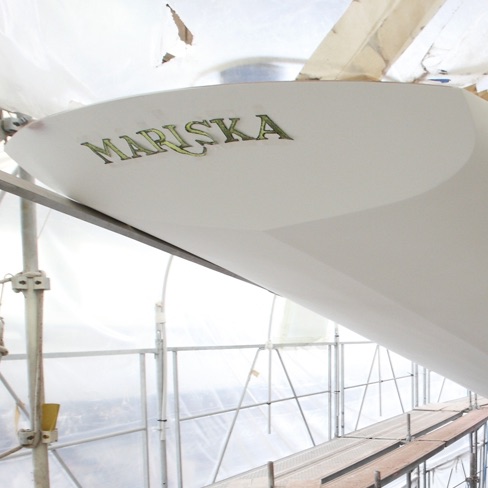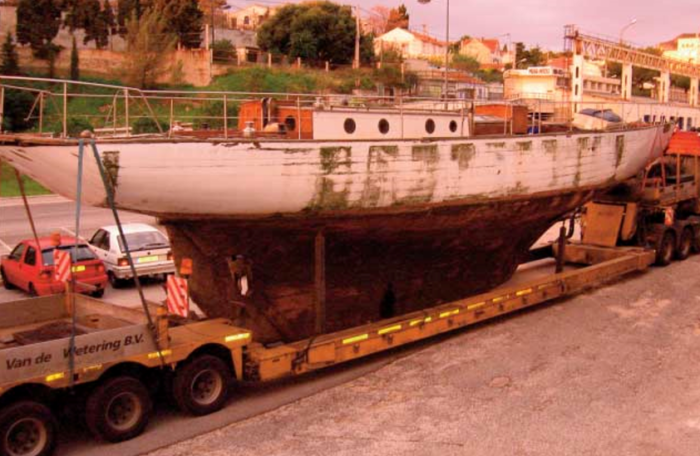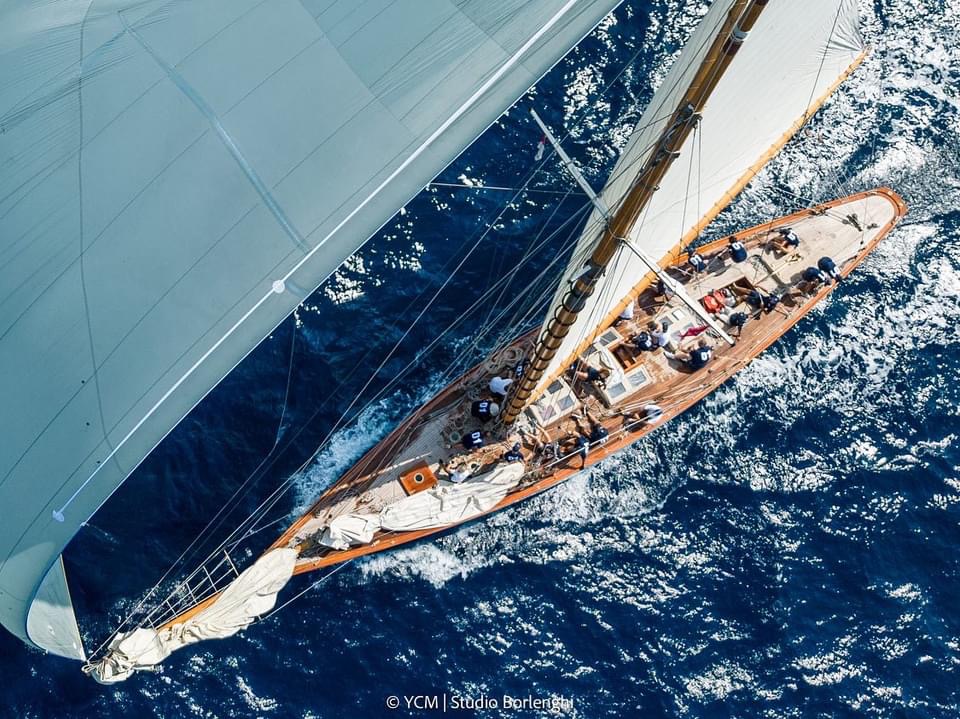Where everything begins in the shipyard of William Fife in fairlie Scotland
Mariska’s History
Since 1908, over 115 years of history

Builder & Year of construction & Model
William Fife III
1908, Launched in April
Gaff Cutter - 15 Meter Class

Lenght (LOA) & Draft & Beam
27,58 m - 90'6"
2,62 m - 8'7"
4,20 m - 13'9"

Sail Area & Engines & Speed
Sail area: Upwind 350 m2 - Downwind 600 m2
Top speed 12 kts - Cruising speed 8 kts
Engine: Yannmar 4JH4-HTE 80.9 kW
Consumption 6 l/h
Top speed 8 kts - Cruising speed 6 kts


Mariska during a delivery 23 May, 1908

Mariska sailing down in cowes 1908

Mariska at anchor 2 may, 1908

Mariska and Paula II racing in 1912

Mariska history starts in the shypyard of William Fife III, Fairlie - Scotland in 1908, when she is ordered by one of the most prominent figures in the yachting world at the time, Mr. Arthur K. Stothert, the treasurer of the Yacht Racing Association Council. Mariska attracted attention from her very first day.
The third 15 Meter class boat being built but the first 15 Meter being designed and built by William Fife III, she was destined for a long and exciting journey. Mariska's racing career as a 15M configuration spanned from 1908 to 1920. Her original owner, Mr. A.K. Stothart, raced her for three seasons, participating in 136 races. Mariska finished first in 44 regattas and took the podium 35 times. Mr. A.K. Stothert, raced her mainly around the coasts of British Isles and few times in France and in Belgium, it is in her first season of racing in July 1908 that Mariska went to Belgium in Ostend where she was racing with Shimma and Britomart, were she finished in third place.

In 1911, Mr. A.K. Stothart commissioned his new 19-meter yacht, Mariquita, and sold Mariska to Captain Frederick Guest. After a couple of months he invited Sir Ralph Gore (later vice commodore of the Royal Yacht Squadron and President of the Royal Yachting Association) to join him as a co-owner.
At the end of 1911 Mariska passed into the hands of J.W. Cook and Blatspiel-Stamp, who supplied her with a new mast and topmast, racing her first in England and then the North sea. During Kiel international week of 1912, she managed a victory against six other 15 meters, including a brand new and radical Istia, who otherwise dominated the season.
In 1913 Blatspiel-Stamp ordered a new 15 M yacht (Maudrey), and Mariska was resold to Carl Krüger, a German merchant living in Gothenburg. Krüger took the boat to Sweden for winter storage, a move that proved wise as the British Admiralty confiscated all German yachts in Cowes harbour a few months before the declaration of war. Mariska benefited the neutrality of Sweden, and raced from 1913 to 1915, winning the Gothenburg regatta in 1913.
In 1916, however her 20-ton lead keel was sold for rifle bullets, putting Mariska at risk of being scrapped.
Saved from the scrapyard by Charles Cahier, who acquired her with the desire to return her to racing, Mariska was renamed Orphée for a short period. The only time in her long history that she changed name. Although Cahier didn't succeed in bringing Mariska back to sailing condition, he played a crucial role in saving her from destruction. In 1917, Cahier sold the boat to Julius Albrechtsson, who later resold her to shipping broker Gosta Dahlman in 1919. Dahlman returned Mariska to the 15M configuration, and she won the Øresund Regatta in Denmark in 1919.

Mariska racing against six other 15 meters from Kiel to Eckernförde 1912

Mariska racing in Sweden

Mariska racing in Sweden in 1913

In 1923, Carl Matthiessen bought Mariska and transformed her into a gaff yawl.
Matthiessen was one of the most charismatic owners of Mariska, who loved, sailed, and raced her intensively for 20 years. Serving as vice president of Royal Swedish Sailing Club (KSSS) for 18 years, he was especially responsible for the youth section. Every spring, when the boat came out of its winter storage, he made Mariska available to the Club, which organized mid-sea cruises for young volunteer crewmembers. In Matthiessen’s hands, Mariska was as popular as ever. In 1924, when she took part in the Visby Cup, an enthusiastic crowd gave her a standing ovation when the cannon fire marked her arrival as a winner. In 1926, Mariska won the event for the third time, and Matthiessen could therefore keep the famous Visby trophy for life. Throughout all these years, Mariska continued to be a star that everyone knows, admires, and considers as a national asset and part of their maritime heritage. In 1939, at the age of 53, Matthiessen decided to re-rig Mariska into a Marconi yawl, but gradually lost interest in her over the next few years. In 1942, he donated the boat to the KSSS.

Mariska rigged as a gaff yawl

Mariska’s crew with Tore Holm onboard
(second from the right)

Mariska rigged as a gaff yawl

KSSS crew during a cruise in 1932

Mariska aground during a regatta in 1933

Mariska rigged as Marconi yawl
The restoration took six years, during which she was re rigged to a Bermudian ketch. Her original deck layout was altered by replacing the original skylight with a large sliding hatch, which brought in air and light, essential for permanent life on board, and above all, allowed Olle to install a piano in the saloon. The stern was shortened by 3 meters, likely due to a lack of funding for a complete restoration of the deteriorated timbers.

Olle Grafström playing piano inside of Mariska

Olle and his wife Suzanne onboard Mariska, just before her stern was shortened

Mariska rigged as a Ketch

Grafström sailed the boat extensively and lived on board with his wife Suzanne until, in 1983, he finally sold her to Jacob De Jonge, her first Dutch owner. De Jonge undertook numerous repairs on the aging Mariska, and it wasn't until 1990 that she was ready to sail again. He sailed her several summers in the Baltic and North sea. In a later letter, he wrote “She was an excellent for family cruising, very safe, and we sailed her in the Baltic sea and the North sea every summer. I have nothing but good memories of this boat, which remains dear to my heart. But in the end she needed major repair work that I was not able to undertake, so I sold her.”
In 2001, he sold the boat to another Dutchman, Edgar Holtbach, who realized the rarity of his possession. Classic racing yachts were gaining popularity, and E. Holtbach anticipated high demand for the famous Mariska. However, his asking price seemed too steep, and after a few years, interest waned and Mariska was left to deteriorate in Delfzijl on the Dutch-German border, were she sank twice due to lack of maintenance.

Bow of Mariska in Netherlands 2004

Mariska rigged as a ketch in Netherlands, 2004

Original tiller that survived until today

Stern of Mariska when she was in Netherlands, 2004

Mr. Christian Niels purchased Mariska in 2007 and committed to a massive restoration to bring her back to full glory, once again rigged as a 15 meter class yacht.
It was decided that as many original parts as possible would be preserved during the restoration of Mariska. Starting with the planking, 65% of which was successfully recovered, along with the oak keel. However, the stem had to be replaced due to its upper section being rotten, as well as the area beneath the mast step.
Deck beams that were still mostly sound were reused, with their rotten ends removed. New beams around the foot of the mast were crafted from Oregon pine.
All spars, expertly crafted by Gilbert Pasqui, were made of spruce, except for the lower mast, which was crafted from Oregon pine. The original steam-bent and steel frames were replaced with laminated frames made from sipo, an African mahogany, and the planking fastening was upgraded to stainless steel.
The original ballast keel was long gone and replaced with a keel made of sheet metal filled with scrap. A new keel had to be made. The lead for the new keel was sourced from the Alinghi IACC SUI- 64.
For waterproofing the planking, splining was favored over caulking. This method involved the insertion of wooden strips or splines, glued between the planks. The splines, like the planks, were made of mahogany above the waterline and iroko below. Plugs that concealed screw heads were also crafted from mahogany. The floors and reinforcing frames inside the boat were made of stainless steel instead of mild steel.
The deck was constructed using the conventional method of laying teak over plywood, ensuring watertightness. All hatches on the deck were made of mahogany.
When it came to hardware, stainless steel was chosen for the mast and the bowsprit, while all the deck hardware, such as sheet lead, clets and stantions, was cast in bronze by Christian Dryade.
The interior was entirely constructed from mahogany, and inspired by the original plans. It included the owner's cabin in the stern, a central saloon, a guest cabin, and crew quarters in the bow.
Both the deck and the hull were painted in Boston white, bringing brightness to the interior. After two and a half years and 25,000 hours of meticulous work, Mariska finally touched the water on September 11, 2009. A month later, she triumphed in her first regatta in Saint Tropez.
Since 2009, Mariska has been a constant presence at all classic yacht events in the Mediterranean, continuing to grow her pedegree in the racing scene.

Arrival of Mariska in La Ciotat

Beginning of the restoration

Replacing the frames

The original keel and the preserved planking

Scarfing the planks to rebuilt the stern of Mariska

Keel of Alinghi, future keel of Mariska

Mariska view from inside with new frames

Touching water in her full glory in 2009

In 2020, she changed ownership once more. Dan Poljsak was appointed captain and Mariska got relocated to Slovenia, where she underwent a significant refit. Thirteen years of intense racing had taken a toll, and seven months of intensive work were dedicated to restoring her back to perfect condition.
The refit led by Dan included repainting the hull, stripping off and recoating all the varnish, changing the black and grey water systems, changing the bushings of the rudder, varnishing and painting the interior, sandblasting and repainting all the stainless hardware, removing and servicing the bronze hardware, changing the propeller shaft and bearings, and a complete overhaul of the engine.
After the refit, she returned to Mediterranean, once more triumphed at the 2021 Monaco Classic Week.
In 2022, Mariska's sister ship, Tuiga, visited the Adriatic Sea, engaging her in several friendly regattas, starting in Venice and continuing to Portorož (Mariska’s home port at the time) and Trieste. Perhaps the most memorable event was the Match race in Venice.
The historic town was closed for marine traffic, creating a stunning backdrop as the two 15-meter yachts put up a spectacular show of tacking up the canal and past the Piazza San Marco in 8-10 knots of wind. Mariska won the regatta.
The season ended with the participation on the Barcolana race in Trieste – The biggest single start regatta in the world. The day started with 25 knots of wind and 1600 boats on the starting line. Mariska finished the regatta on respectable 62nd place over all.

Preparation for varnishing, Portoroz

Preparations for the painting of the hull, Portoroz

Launching after the refit, Portoroz

Monaco Classic Week 2021
The season 2023 brought new and exciting challenges for Mariska. It has become apparent, that in order to continue racing, Mariska will have to cover her own costs. Manon Bajart who joined Mariska in 2022 as a race crew joined forces with Dan in 2023 to develop the project of making Mariska available for charters. Manon therefore took the role of manager and the first mate.
Over the spring of 2023, Mariska was coded a Small Commercial Vessel, and for the first time in her history, she became available for charter.
She participated in seven regattas that season - Vele d'epoca a Napoli, Puig Vela Clasica in Barcelona, Iles Balears Classics in Palma , Vela Clasica Menorca, Monaco Classic Week , Régates Royales de Cannes and Les Voiles de Saint Tropez.
Meanwhile in the middle of the season it has been decided to relocate her back to Mediterranean.
This time her homeport became Real Club Nautico de Barcelona.

Barcolana regatta, in front of the Miramare castle, Trieste 2022

Match race with Tuiga & Mariska,
Venice 2022

Mariska, Tuiga & The Lady Anne in Monaco Classic Week 2023

Mariska with the Manhattan yacht club onboard in Monaco 2023
